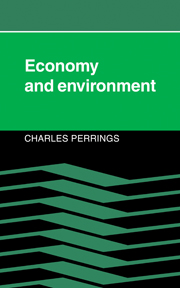 Economy and Environment
Economy and Environment Book contents
- Frontmatter
- Contents
- Preface
- Notation Guide
- 1 Introduction
- Part I The physical economy-environment system
- Part II The economic system
- 5 The price system
- 6 Prices, property, and the environment
- 7 Economic conflict and environmental change
- Part III Environmental strategies in an evolutionary economy-environment system
- References
- Index
7 - Economic conflict and environmental change
Published online by Cambridge University Press: 20 March 2010
- Frontmatter
- Contents
- Preface
- Notation Guide
- 1 Introduction
- Part I The physical economy-environment system
- Part II The economic system
- 5 The price system
- 6 Prices, property, and the environment
- 7 Economic conflict and environmental change
- Part III Environmental strategies in an evolutionary economy-environment system
- References
- Index
Summary
Conflict and change: an historical perspective
The powerful sweep of history, more than anything else, is what distinguishes the works of the classical political economists from the post-Walrasian literature. Walsh and Gram (1980) have, as we have seen, described this as a difference of theme; the theme of the former being “the capacity of an economy to reproduce itself and grow,” that of the latter being “the allocation of given resources.” The contrast between the dynamic approach of one and the static approach of the other is certainly striking. O'Brien (1975) has commented on the irony that something taken so much for granted by the classical political economists could have disappeared so completely in the wake of the marginalist revolution of the 1870s. Although the thematic distinction captures the difference between the dynamic general equilibrium models of the Neumann type and those with a Walrasian basis, however, it fails to reach the classical political economists' obsession with the driving forces of change in the economic system. For even though the dynamic general equilibrium models are satisfied by the introduction of mechanical “time” into a fixed-technology world, the classical political economists were after something much more significant. They were fascinated by the source of the restless change they observed in the capitalist economy – not a mechanical clockwork measure of the rhythms of the economy. Indeed, Marx spent a lifetime trying to uncover the “laws of motion” of a system that was and still is constantly regenerating itself by adopting new guises.
- Type
- Chapter
- Information
- Economy and EnvironmentA Theoretical Essay on the Interdependence of Economic and Environmental Systems, pp. 95 - 108Publisher: Cambridge University PressPrint publication year: 1987


